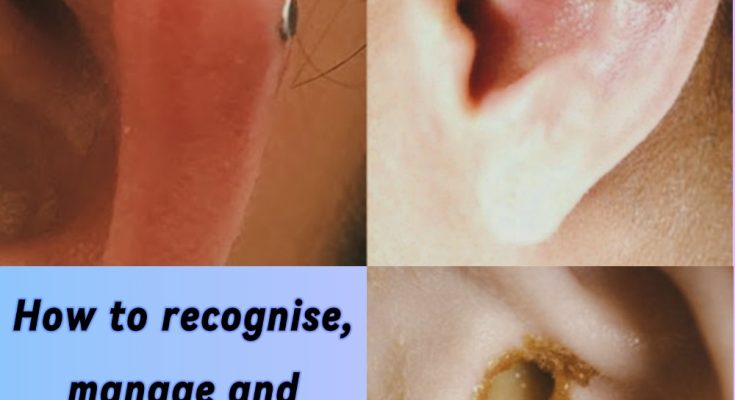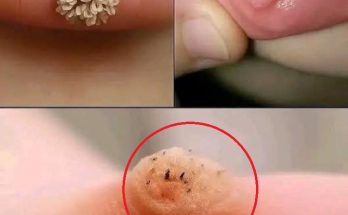An infected ear piercing can be a frustrating and sometimes serious issue. It’s crucial to differentiate between a minor irritation and a true infection, as the treatment approaches differ.
How to Recognize an Infected Ear Piercing vs. Irritation
It’s normal for a new piercing to have some mild redness, swelling, tenderness, and a clear or pale yellow discharge that forms a crust.1 These are signs of normal healing. However, an infection will present with more pronounced and specific symptoms:
Signs of an Infected Ear Piercing:
- Increased and Spreading Redness: The redness goes beyond the immediate piercing site and seems to be getting worse or spreading to a larger area of the ear.2
- Significant Swelling: Swelling that is severe, increasing, or appears after the initial healing period.
- Increased or Worsening Pain: The pain is more intense than initial tenderness, doesn’t subside, or gets worse over time. It might be throbbing.
- Warmth to the Touch: The area around the piercing feels noticeably warm or hot.3
- Pus/Thick Discharge: This is a key indicator. Instead of clear or pale yellow lymphatic fluid, you’ll see thick, yellowish, green, or foul-smelling pus oozing from the piercing.4
- Fever or Feeling Unwell: Systemic symptoms like fever, chills, body aches, or a general feeling of malaise indicate a more serious infection that could be spreading.5
- Streaks of Redness: Red streaks radiating away from the piercing site can indicate a spreading infection (cellulitis).6
- Jewelry Becoming Embedded: Swelling might be so severe that the earring starts to “sink” into the skin.7
Signs of an Irritated Ear Piercing (often confused with infection):
- Mild redness around the piercing.
- Slight swelling.
- Mild pain or tenderness when touched.
- Itching or burning sensation.
- Clear or pale yellowish discharge that crusts around the jewelry (lymph fluid).
- Localized bump (granuloma) that is not pus-filled.
Irritation can be caused by:
- Touching the piercing with dirty hands.8
- Playing with the jewelry too much.9
Using harsh cleaning solutions (like alcohol or hydrogen peroxide)
- Allergic reaction to the jewelry material (often nickel).
- Tight jewelry.
- Trauma to the piercing (e.g., snagging it on clothes, sleeping on it).
How to Manage and Treat an Infected Ear Piercing
The approach depends on the severity of the infection.
For Mild Infections (early signs, no systemic symptoms, no thick pus):
- DO NOT remove the jewelry: Unless advised by a doctor or professional piercer. Removing the jewelry can cause the hole to close, trapping the infection inside the tissue and potentially leading to an abscess.10
- Wash Your Hands Thoroughly: Always, always wash your hands with soap and water before touching your piercing.
- Clean with Sterile Saline Solution:
- You can buy pre-made sterile saline wound wash at a pharmacy.11
- Alternatively, you can make your own: Dissolve 1/4 teaspoon of non-iodized sea salt (not table salt) in 8 ounces (about 240ml) of warm distilled or boiled water that has cooled down.
- Method:
- Soak a clean cotton ball, gauze pad, or paper towel in the saline solution.
- Gently hold the soaked pad to both sides of the piercing for 5-10 minutes. This helps soften crusts and allows the saline to penetrate.
- Gently clean around the piercing site to remove any crusts or discharge.12 Do not pick or force anything off.
- Rinse gently with plain warm water (optional, but can help remove any remaining salt residue).
- Gently pat the area dry with a clean paper towel (cloth towels can harbor bacteria or leave fibers).13
- Frequency: Do this 2-3 times a day.
- Warm Compress: Applying a warm, moist compress (a clean cloth soaked in warm water) for 10-15 minutes, several times a day, can help promote blood flow, reduce swelling, and draw out any minor pus.14
- Avoid Irritants:
- Do not use alcohol, hydrogen peroxide, antibacterial soaps, or harsh ointments (like Neosporin/Bacitracin) unless specifically told to by a doctor. These can irritate the piercing, kill healthy cells, and delay healing.
- Avoid touching or playing with the jewelry excessively.
- Keep hair, makeup, and other products away from the piercing.
- Maintain Good Hygiene: Change your pillowcase frequently, and keep phones and headphones clean.15
When to See a Doctor (Important!):
You should seek medical attention promptly if you experience any of the following:
- Signs of a more serious infection: Thick, yellowish/green/foul-smelling pus, increasing pain, severe redness/swelling that is spreading, red streaks.
- Fever, chills, or general feeling of illness.
- The jewelry becoming embedded or difficult to move.
- The infection doesn’t improve with home treatment within 24-48 hours.
- The piercing is in the cartilage (upper ear): Cartilage infections are more serious and can lead to permanent deformity (e.g., “cauliflower ear”) if not treated aggressively with specific antibiotics.16 They don’t have as good a blood supply as earlobes, making them harder to treat.
- The piercing is in a baby or young child.
- You have a weakened immune system or other underlying health conditions.17
Medical Treatment for Infected Ear Piercings:
A doctor will assess the infection and may:
- Prescribe Antibiotics:
- Topical antibiotics: Creams or ointments for mild, localized infections.18
- Oral antibiotics: For more severe infections, especially cartilage piercings, or if there are systemic symptoms.19 It’s crucial to complete the full course of antibiotics as prescribed.
- Drain an Abscess: If a pocket of pus (abscess) has formed, the doctor may need to drain it.
- Adjust or Remove Jewelry: In some cases, the doctor might recommend changing the jewelry to a different material (e.g., surgical steel or titanium if an allergy is suspected) or a longer post if swelling is an issue. In very rare and severe cases, they might advise removing the jewelry to allow the infection to drain, but this is usually a last resort to prevent trapping the infection.
- Referral: For complex or persistent cases, a referral to a dermatologist or an ear, nose, and throat (ENT) specialist may be necessary.
Prevention is Key:
- Choose a Reputable Piercer: Ensure they use sterile equipment, follow strict hygiene protocols, and are licensed.
- Proper Aftercare: Follow your piercer’s aftercare instructions diligently.
- Hands Off: Avoid touching your new piercing unless you are cleaning it with thoroughly washed hands.20
- Appropriate Jewelry: Start with high-quality, hypoallergenic jewelry (surgical stainless steel, titanium, 14k or 18k gold). Avoid nickel.
- Be Patient: Let the piercing heal completely before changing jewelry.21 Earlobe piercings can take 6-8 weeks, while cartilage piercings take 3-12 months or even longer.22

